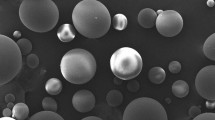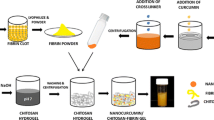Abstract
Purpose
We hypothesize that the controlled delivery of rhVEGF using a microsphere/hydrogel combination system could be useful to achieve active blood vessel formation in the ischemic hindlimb mouse model, which is clinically relevant for therapeutic angiogenesis without multiple administrations.
Methods
A combination of poly(d,l-lactide-co-glycolide) (PLGA) microspheres and alginate hydrogels containing rhVEGF was prepared and injected intramuscularly into the ischemic hindlimb site of mouse model, and new blood vessel formation near the ischemic site was evaluated.
Results
The controlled release of rhVEGF from the combination system effectively protected muscles in ischemic regions from tissue necrosis. Interestingly, the number of newly formed, active blood vessels was significantly increased in mice treated with the rhVEGF-releasing combination system.
Conclusion
A microsphere/hydrogel combination system provided a useful means to deliver therapeutic angiogenic molecules into the body for the treatment of ischemic vascular diseases, which could reduce the number of administrations of many types of drugs.







Similar content being viewed by others
References
Lange R, Weipert J, Homann M, Mendler N, Paek SU, Holper K, et al. Performance of allografts and xenografts for right ventricular outflow tract reconstruction. Ann Thorac Surg. 2001;71:S365–7.
Cutler JA, Thom TJ, Roccella E. Leading causes of death in the United States. JAMA. 2006;295:383–4.
Miura SI, Saku K. Regulation of angiogenesis and angiogenic factors by cardiovascular medications. Curr Pharm Design. 2007;13:2113–7.
Schmidt A, Brixius K, Bloch W. Endothelial precursor cell migration during vasculogenesis. Circ Res. 2007;101:125–36.
Chu Y, Miller JD, Heistad DD. Gene therapy for stroke: 2006 overview. Curr Hypertens Rep. 2007;9:19–24.
Asahara T, Bauters C, Zheng L, Takeshita S, Bunting S, Ferrara N. Synergistic effect of vascular endothelial growth-factor and basic fibroblast growth-factor on angiogenesis in-vivo. Circulation. 1995;92:365–71.
Baffour R, Berman J, Garb J, Rhee S, Kaufman J, Friedmann P. Enhanced angiogenesis and growth of collaterals by in vivo administration of recombinant basic fibroblast growth factor in a rabbit model of acute lower limb ischemia: dose-response effect of basic fibroblast growth factor. J Vasc Surg. 1992;16:181–91.
Morishita R, Nakamura S, Hayashi S-I, Taniyama Y, Moriguchi A, Nagano T, et al. Therapeutic angiogenesis induced by human recombinant hepatocyte growth factor in rabbit hind limb ischemia model as cytokine supplement therapy. Hypertension. 1999;33:1379–84.
Shyu K-G, Manor O, Magner M, Yancopoulos GD, Isner JM. Direct intramuscular injection of plasmid DNA encoding angiopoietin-1 but not angiopoietin-2 augments revascularization in the rabbit ischemic hindlimb. Circulation. 1998;98:2081–7.
Su E, Cioffi C, Stefansson S, Mittereder N, Garay M, Hreniuk D. Gene therapy vector-mediated expression of insulin-like growth factors protects cardiomyocytes from apoptosis and enhances neovascularization. Am J Physiol-Heart Circul Physiol. 2003;284:H1429–40.
Ahn A, Frishman W, Gutwein A, Passeri J, Nelson M. Therapeutic angiogenesis: a new treatment approach for ischemic heart disease-part I. Cardiol Rev. 2008;16:163–71.
Sato K, Wu T, Laham RJ, Johnson RB, Douglas P, Li J, et al. Efficacy of intracoronary or intravenous VEGF165 in a pig model of chronic myocardial ischemia. J Am Coll Cardiol. 2001;37:616–23.
Takeshita S, Zheng L, Brogi E, Kearney M, Pu L, Bunting S. Therapeutic angiogenesis. A single intraarterial bolus of vascular endothelial growth factor augments revascularization in a rabbit ischemic hind limb model. J Clin Invest. 1994;93:662–70.
Baumgartner I, Pieczek A, Manor O, Blair R, Kearney M, Walsh K, et al. Constitutive expression of phVEGF(165) after intramuscular gene transfer promotes collateral vessel development in patients with critical limb ischemia. Circulation. 1998;97:1114–23.
Epstein SE, Kornowski R, Fuchs S, Dvorak HF. Angiogenesis therapy: Amidst the hype, the neglected potential for serious side effects. Circulation. 2001;104:115–9.
Morishita M, Peppas NA. Is the oral route possible for peptide and protein drug delivery? Drug Discov Today. 2006;11:905–10.
Chung YI, Ahn KM, Jeon SH, Lee SY, Lee JH, Tae G. Enhanced bone regeneration with BMP-2 loaded functional nanoparticle-hydrogel complex. J Contol Release. 2007;121:91–9.
Hiemstra C, Zhong ZY, van Steenbergen MJ, Hennink WE, Jan FJ. Release of model proteins and basic fibroblast growth factor from in situ forming degradable dextran hydrogels. J Control Release. 2007;122:71–8.
Gombotz WR, Wee SF. Protein release from alginate matrices. Adv Drug Deliv Rev. 1998;31:267–85.
Anderson JM, Shive MS. Biodegradation and biocompatibility of PLA and PLGA microspheres. Adv Drug Deliv Rev. 1997;28:5–24.
Lee KY, Peters MC, Mooney DJ. Comparison of vascular endothelial growth factor and basic fibroblast growth factor on angiogenesis in SCID mice. J Control Release. 2003;87:49–56.
Lee J, Lee KY. Injectable microsphere/hydrogel combination systems for localized protein delivery. Macromol Biosci. 2009;9:671–6.
Lee J, Tan CY, Lee S-K, Kim Y-H, Lee KY. Controlled delivery of heat shock protein using an injectable microsphere/hydrogel combination system for the treatment of myocardial infarction. J Control Release. 2009;137:96–202.
Lee J, Lee KY. local and sustained vascular endothelial growth factor delivery for angiogenesis using an injectable system. Pharm Res. 2009;26:1739–44.
Yang Y-Y, Chung T-S, Ping Ng N. Morphology, drug distribution, and in vitro release profiles of biodegradable polymeric microspheres containing protein fabricated by double-emulsion solvent extraction/evaporation method. Biomaterials. 2001;22:231–41.
Kamihata H, Matsubara H, Nishiue T, Fujiyama S, Amano K, Iba O, et al. Improvement of collateral perfusion and regional function by implantation of peripheral blood mononuclear cells into ischemic hibernating myocardium. Arterioscler Thromb Vasc Biol. 2002;22:1804–10.
Shimpo M, Ikeda U, Maeda Y, Takahashi M, Miyashita H, Mizukami H, et al. AAV-mediated VEGF gene transfer into skeletal muscle stimulates angiogenesis and improves blood flow in a rat hindlimb ischemia model. Cardiovasc Res. 2002;53:993–1001.
Vajanto I, Rissanen TT, Rutanen J, Hiltunen MO, Tuomisto TT, Arve K, et al. Evaluation of angiogenesis and side effects in ischemic rabbit hindlimbs after intramuscular injection of adenoviral vectors encoding VEGF and LacZ. J Gene Med. 2002;4:371–80.
Jeon O, Kang S-W, Lim H-W, Hyung Chung J, Kim B-S. Long-term and zero-order release of basic fibroblast growth factor from heparin-conjugated poly(l-lactide-co-glycolide) nanospheres and fibrin gel. Biomaterials. 2006;27:1598–607.
Tabata Y, Miyao M, Ozeki M, Ikada Y. Controlled release of vascular endothelial growth factor by use of collagen hydrogels. J Biomater Sci-Polym Ed. 2000;11:915–30.
Tae G, Scatena M, Stayton P, Hoffman A. PEG-cross-linked heparin is an affinity hydrogel for sustained release of vascular endothelial growth factor. J Biomater Sci-Polym Ed. 2006;17:187–97.
Patil SD, Papadmitrakopoulos F, Burgess DJ. Concurrent delivery of dexamethasone and VEGF for localized inflammation control and angiogenesis. J Control Release. 2007;117:68–79.
Silva EA, Mooney DJ. Spatiotemporal control of vascular endothelial growth factor delivery from injectable hydrogels enhances angiogenesis. J Thrombos Haemost. 2007;5:590–8.
Lewandowski TA, Ponce RA, Charleston JS, Hong S, Faustman EM. Changes in cell cycle parameters and cell number in the rat midbrain during organogenesis. Dev Brain Res. 2003;141:117–28.
DeLisser HM, Newman PJ, Albelda SM. Molecular and functional aspects of PECAM-1/CD31. Immunol Today. 1994;15:490–5.
Acknowledgments
This work was supported by National Research Foundation of Korea Grant funded by the Korean Government (2009-K001598, 2009-0065528), and also by grant from World Class University Project, Ministry of Education, Science and Technology, Republic of Korea (200900000000024). Authors acknowledge Byung-Gee Kim and Eunjung Song for their assistance in western blot analysis.
Author information
Authors and Affiliations
Corresponding authors
Additional information
Authors Jangwook Lee and Suk Ho Bhang contributed equally to this work.
Rights and permissions
About this article
Cite this article
Lee, J., Bhang, S.H., Park, H. et al. Active Blood Vessel Formation in the Ischemic Hindlimb Mouse Model Using a Microsphere/Hydrogel Combination System. Pharm Res 27, 767–774 (2010). https://doi.org/10.1007/s11095-010-0067-0
Received:
Accepted:
Published:
Issue Date:
DOI: https://doi.org/10.1007/s11095-010-0067-0




